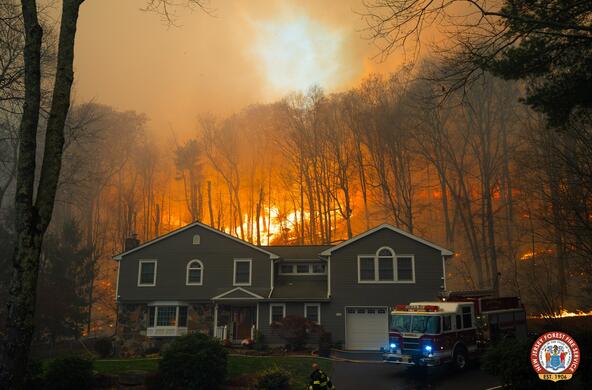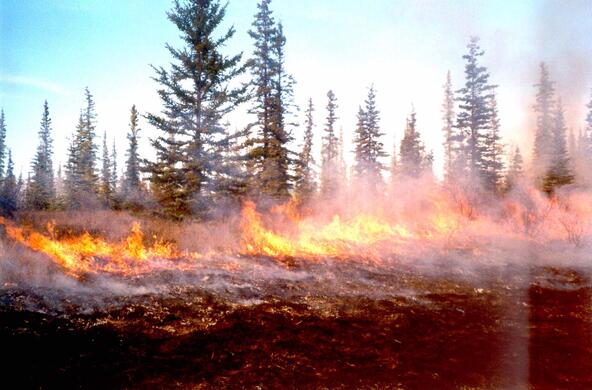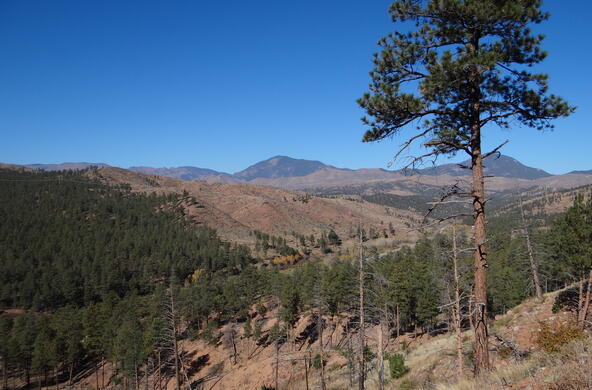Cary forest ecologist Winslow Hansen is developing new ways to project future wildfire activity in western North America and determine how and why forests may respond. Here, Hansen discusses how fires in the western United States are changing, what this means for people and ecosystems, and how fire modeling can guide management.
How do wildfires start?
Wildfires start when there is a combination of heat, ignition sources (people, storms), and fuel (like dry leaves, branches, and dead grass) on the landscape.
In the western US, higher temperatures and worsening droughts create favorable conditions for wildfires to break out. More frequent, intense storms come with lightning strikes that can ignite dangerous blazes, and strong winds that move fire across the landscape. Climate change is amplifying these factors.
The abundance of fuel on the landscape is also critical. More fuel feeds bigger fires.
What factors influence wildfire regimes?
‘Wildfire regime’ describes the pattern of fire frequency, size, and severity that is typical in a landscape over long periods of time – on the scale of thousands of years. Geographic variability in climate, forest types, and historic Indigenous burning practices shape unique fire regimes across different regions. And, since some plant species burn hotter and easier than others, the type of vegetation growing in a region influences the fires that burn there.
How many wildfires are caused by humans?
People are the primary cause of wildfires. In the continental US, people accounted for 84% of wildfires ignited, and 44% of area burned, between 1992-2012. Things like fireworks, tossed cigarette butts, stray embers from campfires and grills, and sparks from cars, power tools, or even lawnmowers striking stones, can start devastating wildfires.
Plus, people are increasingly building homes in fire-prone wildlands – where forests and dwellings are interspersed. More people living in these areas increases fire danger.
Together, people and climate change are extending the fire season, which now starts in April and runs well into November and even December.
Why are some wildfires good?
Fire is a natural part of many ecosystems and promotes plant and wildlife diversity. By clearing underbrush, fire allows light to reach the forest floor and helps young trees grow. Plus, when fallen leaves, branches, and other dead plant matter burn, the ashes enrich forest soils.
Many species rely on fire during key life stages. For example, tree species like lodgepole pine produce cones sealed by resin that only open and expose their seeds when heated by fire.
Some types of fungi disperse their spores through wildfire smoke. Other plants drop seeds that require the chemicals in smoke, or ash-enriched soil, to activate.
Periodic fires also remove excess fuel from the landscape. Less fuel means the next fire will have less to burn, reducing the risk of an uncontrollable blaze. Even if mature trees perish in a smaller ‘routine’ fire, reproductive adaptations help ensure a new generation of seedlings will replace them.
Are wildfires increasing?
Across the western United States, large fires are becoming more frequent and severe. Annual burned forest area has increased by about 1,100% since 1984.
Why are wildfires getting worse?
Heat waves, droughts, and increased ignitions are exacerbating fire risk.
Fires have also been suppressed, and Indigenous burning practices stopped, for more than a century. This fire deficit has led to an abundance of brush and dead plant debris in some western landscapes. Paired with drying conditions, this is a recipe for more fire.
How are increased wildfires impacting us now?
Lives, property, and livelihoods are routinely threatened by fire. In recent years, we have seen whole towns, like Paradise, California and Fort McMurray, Canada, completely destroyed by wildfire.
Other effects include health consequences of inhaling smoke, which can impact communities far from the flames – sometimes whole continents away. Poor air quality due to smoke can cause wheezing, runny nose, eye irritation, and difficulty breathing. People with lung and heart disease, as well as children and older adults, are at increased risk of severe health complications due to wildfire smoke inhalation.
How are wildfires changing ecosystems?
We are already beginning to see the ecological consequences of changing fire behavior. Across many forest types in the western US, unusually frequent and large fires are killing seedlings before they can drop seeds. This reduces the seed supply that would ensure forest regeneration. Plus, extremely hot and dry conditions post-fire are killing the young trees that do establish. This could lead to transitions from forests to grasslands.
How are you projecting future fire activity?
We use computer models and information on climate, fuel density, and ignition sources – like lightning and human error – to tell us how fire regimes and forests may change, and what factors might alter outcomes. This allows us to develop projections of how fire will affect forests in western North America through the 21st century.
How can models inform management?
We can use our models to test bold management interventions and evaluate consequences without risk. Using computer simulations, we can ‘treat’ large swaths of forest to see what happens if we remove all trees of a certain size, or remove fuels from the forest floor. What happens if we suppress all fires, or suppress none? Insights can help determine where and when certain interventions might be most effective.
Someday, I’d like to organize workshops where managers and scientists come together to explore novel potential solutions that could save lives and ecosystems.
What can we do to adapt?
Homeowners can take precautions such as building with fire-resistant materials, and removing trees and brush around their homes. Many communities have Firewise organizations that provide guidance for such activities. On public lands abutting communities, we need to explore how proactive measures like prescribed burning, managed wildfire use (allowing naturally-ignited fires to burn), and clearing fuels from the landscape might influence fire risk for people.
Forests and fire regimes of the western US are extremely diverse, which means landscape scale forest and fire management must consider the local context, accounting for regionally specific factors like forest type, fire regime, and the communities of people that live there. After large fires occur, we also need to think carefully about how forests might adapt to a changing climate.
Fire is going to be an inevitable component of many regions going forward. We need to learn how to coexist with fire, and how to implement site-specific adaptation strategies that can support people and changing ecosystems.






